

Vol. 41 (Issue 08) Year 2020. Page 25
VASILEV, Yurii N. 1 & TSVETKOVA, Anna Y. 2
Received: 30/10/2019 • Approved: 03/03/2020 • Published 12/03/2020
ABSTRACT: The paper considers the main strategic objectives facing the coal industry of the Russian Federation. The recommendations of improving methods of providing GAP-analysis of the coal industry of the Russian Federation are given. Compliance assessment of the planned and actual strategic indicators of the coal industry activity by means of GAP-analysis tools is made. The authors have defined specific types of "gaps" for coal industry of the Russian Federation. |
RESUMEN: El artículo considera los principales objetivos estratégicos que enfrenta la industria del carbón de la Federación de Rusia. Se dan las recomendaciones para mejorar los métodos que proporciona el GAP-análisis de la industria del carbón rusa. Se realiza una evaluación de cumplimiento de los indicadores estratégicos planificados y reales de la actividad de la industria del carbón por medio de herramientas del GAP-análisis. Los autores han definido tipos específicos de "brechas" para la industria del carbón de la Federación de Rusia. |
The key directions of fuel and energy section development in Russia are the following: reducing power consumption and increasing power efficiency; the accelerated upgrades of fixed assets; improving investment attractiveness; export potential development; formation of the internal competitive environment; steady power supply of industry and citizens. At the moment the key indicator is decreasing power consumption of GDP (Galiyev, 2015).
The Long-term program of the Russian coal industry development till 2030 was approved by the order of the Government of the Russian Federation January 24, 2012 No. 14-r (The Long-term program, 2012). In this program the volume of coal mining equal to 325 million tons has been defined as the minimum volume providing corporate efficiency of the coal industry in 2030. The top limit of coal mining development is 430 million tons.
However, taking into account changes and challenges of the last years as well as decisions of the Government of the Russian Federation, there was a requirement of making amendments in the Long-term program. Thus, the Ministry of Energy of the Russian Federation adopted the Program of the coal industry development till 2030 in 2014 (further - the Program). The new edition of the Program involves the annual volume of coal mining up to 480 million tons (according to the optimistic scenario) or 410 million tons (according to the pessimistic scenario) by the year of 2030 (The Long-term program, 2014).
Besides, the program of steaming coal preparation development in Russia has been adopted. According to it the volumes of coal preparation will increase to 345 million tons by 2030 (the growth by 1,9 times in comparison with the level of 2015) (Peng, 2016).
The obligatory requirements for perspective development of the coal industry are stated in the Program (The Long-term program, 2014):
· decreasing expenses of coal production and transportation, ensuring competitive advantage of coal export to developing countries which increase volumes of fuel and power resources use;
· the maximum use of improving quality reserves of supplied coal to expand its consumer's use and cut down its transportation cost;
· making easy access of coal companies to the market of the loan capital for financing production modernization and increasing work safety;
· gradual modernization of coal industry which allows to increase efficiency of labour;
· transition from trade of "crude" energy resource in the external and internal markets to trade of hi-tech "power product" which provides increasing productivity coefficient of its final use (on the basis of advanced coal processing) and cutting down transport costs for consumer delivery.
The influence of the main risks causes a number of system problems of the Russian coal industry development (Gribin, 2017; Smotrihin, 2016):
· intensification of dependence on external coal environment caused by increasing export orientation while at the same time reducing capacity of domestic market and maintenance of production level and transport expenses;
· high risks of projects implementation of new fields development in the light of industry dependence on use of foreign mining equipment in the conditions of sanctions and limited access to credit resources;
· continuous reduction of increasing labour productivity reserves with the simultaneous growth of operational expenses owing to pay rise, electricity rate increase as well as prices for materials;
· insufficient development of outsourcing;
· tough requirements for implementing license agreements to provide exploration and production works that cause unprofitable development of a considerable share of coal fields sites.
One of the factors having negative effect on coal mining growth rates is the competition with natural gas. Since thermal power plants of Primorsky region of Russia started using gas instead of coal in 2017, the volumes of coal mining have decreased by 2,7 times in this region (URL: http://tass.ru/ekonomika/4959230).
Important aspect of ensuring efficiency of any project implementation, including such global as the coal branch of Russia, is monitoring of indicators achievement (efficiency indicators). For this purpose the Program contains more than forty main target indicators. Among them there are such indicators as:
· coal mining in Russia;
· coal mining per capita engaged in coal industry;
· updating of production capacities;
· average number of injury cases causing death;
· delivery volumes to various segments of domestic market
· export deliveries volumes;
· assets profitability of coal enterprises;
· heat equivalent of coal production for power industry;
· a share of prepared steam coal in the total volume of its production;
· a price ratio of gas/coal in domestic market;
· average range of coal production transportation.
The program provides three stages: I (2012-2015); II (2016-2020); III (2021-2030). Control values of target indicators for the end of each stage have been established. Control values of some indicators for 2025 have been already established (The Long-term program, 2014).
The process of the Program implementation is controlled by the Ministry of Energy of the Russian Federation. The Deputy Minister of Energy A. Yanovsky noted that "... during 2012-2016 the program was implemented successfully regarding to its potential production development. It means growth of mining volume and production of marketable output in general as well per capita engaged in the industry. The export volume will exceed the level of 185 million tons in 2017 (Yanovsky, 2017). Thus, together with prices increase of foreign markets it will allow to intensify investment process and provide target achievement to update production capacities" (Yanovsky, 2017).
The research objective is to carry out the analysis of the Russian coal industry achievements in 2017, discrepancies identification between the actual and planned values as well as identifying their reasons.
The research hypothesis is "gaps" existence in achieving target indicators of strategic development of the Russian coal industry.
The issues connected with competitiveness of coal production, coal-mining enterprise as well as coal industry in general are considered in the different scientific works: Afanasieva et al. (2018), Aleksandrova et al. (2015), Kozlov et al. (2017), Lenkovets et al. (2017), Marinina (2019), Plotkin et al. (2017), Tarazanov (2018), Tkacheva et al. (2015), Tsvetkova et al. (2017), Yanovsky (2017) and the others. These scientists note the importance of strategic decision tools for enterprises.
Enterprise strategic decisions tools are various tools, including methods of SWOT-analysis and GAP-analysis developed within the American management theory (Borovikov, 1999; Mhitaryan, 2006; Markovskiy, 2012).
It is a well-known fact that SWOT analysis is a tool for strategic management. It provides complex analysis of enterprise strengts and weaknesses and its opportunities and threats. SWOT analysis is primarily aimed at enterprise development strategy. The object of SWOT analysis can be an enterprise as well as industry or country.
It should be noted there is no sufficient number of research works devoted to the GAP-analysis both Russian and foreign scientists. It concerns not only theoretical consideration of the GAP-analysis methods but also its tools development for application in various branches of national and foreign economies. Such scientists as Borovikov A., Ruben R., Markovskiy V., Mkhitaryan S.V. consider the issues of methodology of the strategic analysis including GAP-analysis in their research works (Borovikov, 1999; Markovskiy, 2012; Mhitaryan, 2006).
The GAP-analysis is a complex research aiming at identification and analysis of discrepancies, gaps between the actual and planned level of enterprise indicators (Mhitaryan, 2006). Carrying out such analysis allows to allocate problem zones (bottlenecks) preventing to reach planned targets and estimate degree of company readiness to achieve target indicators.
The GAP-analysis can be applied in daily practice to increase overall performance of the separate directions of the company as well as in the process of strategic planning (Markovskiy, 2012). In the latter case the GAP-analysis application is the most effective one as it allows to be realistic about accomplishability and efficiency of the planned purposes and tasks before they are coordinated, approved and financially supported.
Table 1 presents different types of "gaps" arising in any company operation.
The GAP-analysis general scheme is presented in Fig.1.
The GAP-analysis is recommended to be carried out alongside SWOT-analysis. The operating procedures are given in Figure 2.
The paper mainly focuses on the methodology of carrying out the GAP-analysis applying to the coal industry of the Russian Federation. The paper main objective is to identify gaps between the planned values of the key coal branch indicators and their actually obtained values.
Table 1
Types and description of "gaps"
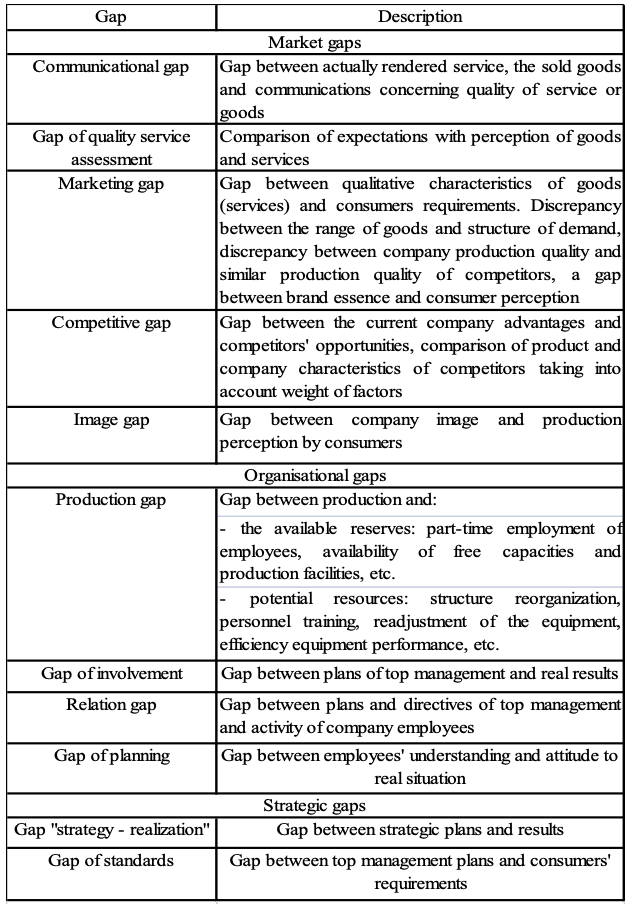
Source: Borovikov, 1999
------
Figure 1
Methodology of carrying out GAP-analysis
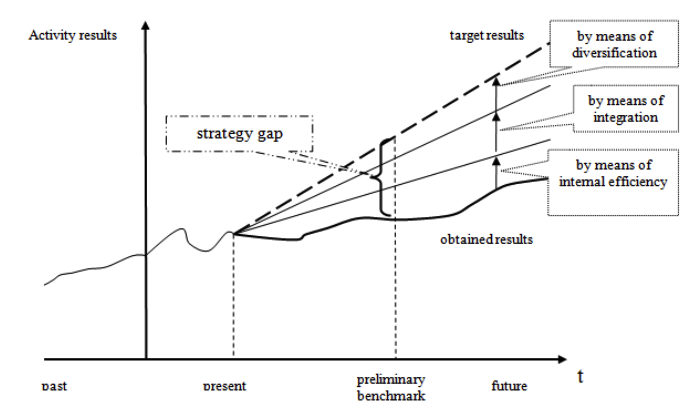
Source: Mhitaryan, 2006
------
Figure 2
Algorithm of GAP- and SWOT-analysis
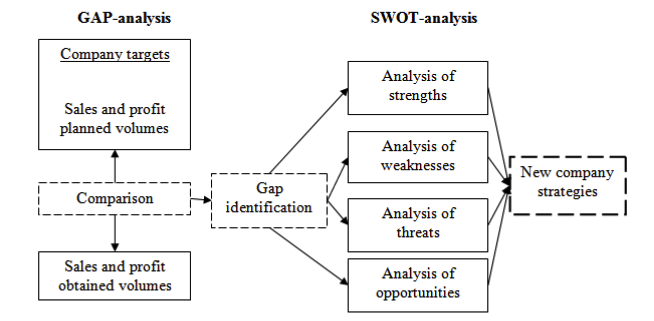
Source: Markovskiy, 2006
Having done the literature review devoted to the methodology the GAP-analysis it has shown that the GAP-analysis includes the main stages:
1. Determination of obtained value.
2. Determination of the most available (target) value.
3. Choice of comparison criterion (criteria).
4. Tools formation for achieving target value.
In our opinion, it is necessary to provide a detailed approach to carry out the GAP-analysis. It is possible to offer the following sequence of operations to perform such analysis:
1. Identification of gaps between the actual and planned results:
1.1. Definition of the key (strategically important) indicators defining strategic competitive advantages.
1.2. Determination of target value indicators;
1.3. Determination of the actual values of such indicators;
1.4. Gap defining between planned and actual values of the specified indicators.
2. Cause identification and gaps elimination between earlier revealed actual and planned results;
2.1. Assessment of "gap" size and criticality for achieving target value indicators;
2.2. Identification of the factors having influenced on "gap" emergence;
2.3. Actions elaboration for gap elimination.
We have carried out the research in the following order:
The indicators mentioned above have been taken into consideration by the Long-term program. The carried out analysis are based on the following key indicators:
· annual volumes of coal mining in Russia;
· coal export volumes;
· the delivery volume for power plants requirement in domestic market;
· return on assets (ROA) of the Russian coal enterprises.
We use the industry statistics data for the period of 5-7 years as well as the results of our researches for determining such values.
The target indicators data are taken from Appendices No. 3 and No. 9 of the Long-Term Program of the coal industry development till 2030 (The Long-term program, 2014). The actual values of indicators were taken from different scientific publications (Vasilev, 2015), (Yanovsky, 2017) and industry reviews (Tarazanov, 2018).
Our researches show that coal production volumes must be increased by 1,8% annually in order to obtain the expected value of coal mining (from 352 million tons in 2013 up to 480 million tons in 2030). Annual growth of coal production volume is to be 0,9% for achieving results of pessimistic scenario (410 million tons) (Vasilev, 2015).
Figure 3 presents data referring to the planned and actual values of "coal mining" indicator. They allow to conduct the GAP-analysis of the indicator.
As the carried out research shows, the average growth rate of coal mining for the last 6 years is 3,7%. Coal mining grows at the advancing rates so it is possible to say there is no gap referring to the "coal mining" indicator. The trend shows that in the case of maintaining the existing growth production rates, the target production indicator will exceed more than 700 million tons by 2030. Thus, it will exceed target value of 480 million tons by 45,8%. However, it should be noted that the coal mining depends on gas production increase in Primorsky region which was mentioned above. Negative impact of such factor as the competition with gas can lead to gap emergence between planned and actual targets of coal mining in the future.
The results of the analysis of coal export volumes indicator are presented in Figure 4.
Figure 3
Results of the GAP-analysis
of the coal mining in Russia
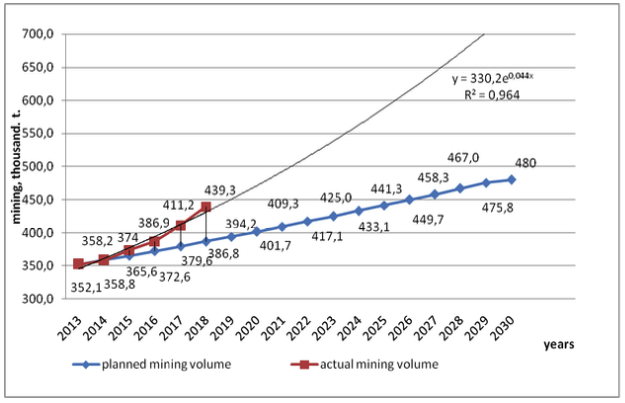
Source: the author's researches
-----
Figure 4
Results of the GAP-analysis
of coal export volumes in Russia
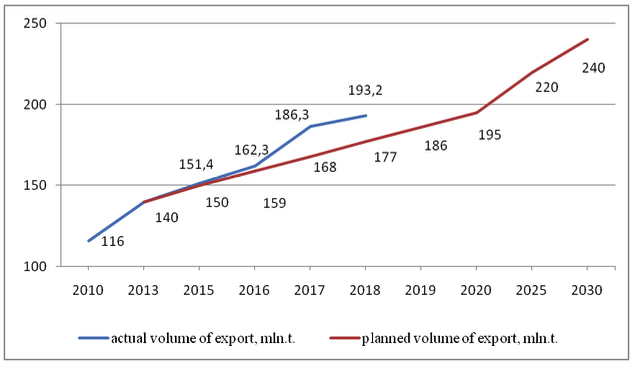
Source: the author's researches
Mln. t. – million tons.
Figure 4 shows that the actual volume of Russian coal export is 5,7% higher than the planned one for the last 4 years.
The results of the analysis referring to the indicator "the volume of deliveries for needs of power industry" are presented in domestic market at Figure 5.
Figure 5
The results of the GAP-analysis of coal deliveries
volumes for requirements of power plants in Russia
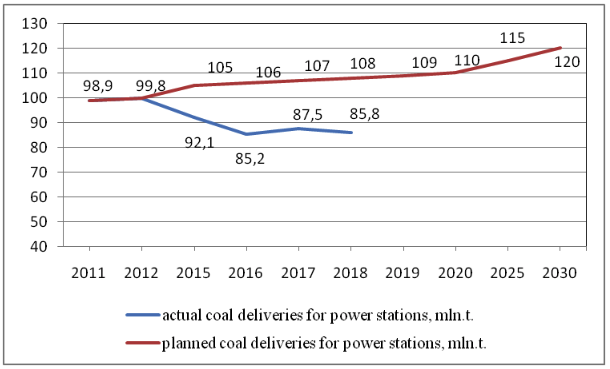
Source: the author's researches
Mln. t. – million tons.
Fig.5 shows that the actual volume of coal deliveries for power stations has not been higher than planned one since 2012. So we can identify "a gap" according this indicator.
To implement the analysis of profitability of assets indicator we have used the data of annual reports provided by the three largest enterprises of the Russian coal industry (Tab. 2).
The data presented in Tab. 2 allow to identify the gap: the target indicator did not reach a half of its value in 2015.
Table 2
GAP-analysis of profitability of
assets of the Russian coal branch
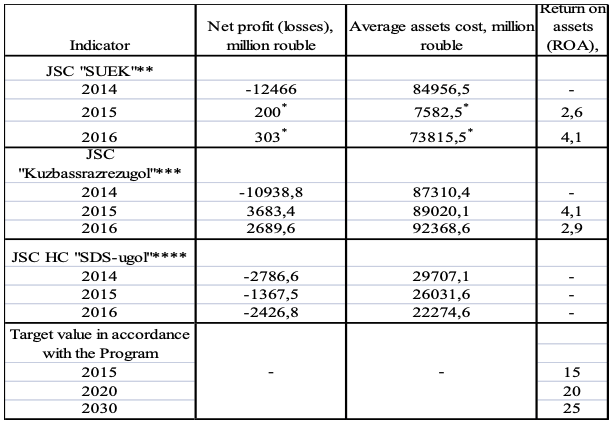
* $ million;
** JSC "SUEK" - a joint-stock company "Sibirskaya ugol'naya energeticheskaya kompaniya" ("Siberian Coal Energy Company");
*** JSC "Kuzbassrazrezugol" - a joint-stock company "Kuzbassrazrezugol";
**** JSC HC "SDS-ugol" – a joint-stock company "Holding company Sibirskiy Delovoy Soyuz-ugol" ("Siberian Business Union-Coal").
Source: it has been calculated using annual accounting reports of the coal companies.
The final results of carrying out the GAP-analysis of the coal industry of the Russian Federation are presented in Tab. 3.
Failure to meet the deadline of the planned power plants construction can be one of the gap reasons in supply volume for requirements of power industry. Thus, putting into operation of the first stage of Sakhalin GRPP-2 (120 MW) was planned in 2016 (Yanovsky, 2017). However, it has been postponed till June, 2018 (Yanovsky, 2017).
Table 3
Results of the GAP-analysis of the coal enterprise
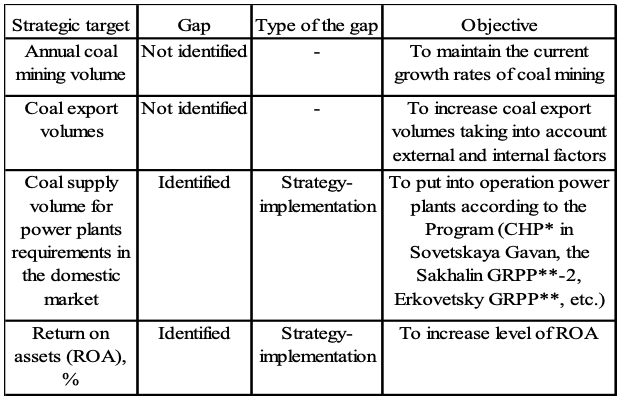
* CHP – combined heat and power;
** GRPP – governmental regional power plant.
CHP with power capacity of 120 MW in Sovetskaya Gavan was planned to launch at the end of 2017. Erkovetsky GRPP simultaneously with the CHP construction (which power capacity is 4800 MW) as well as development of coal pit with coal mining up to 25 million tons are planned in 2021 (Yanovsky, 2017).
The reason of the ROA gap is insufficient volumes of net profit of the coal enterprises. In HC "SDS-ugol", in particular, it was observed the large percent volume of payment which is comparable with total revenue in 2016 (Smotrihin, 2016). JSC "Kuzbassrazrezugol" had net profit decline while increasing average cost of assets that caused ROA decrease in 2016 (Smotrihin, 2016).
Thus, it is possible to confirm the research hypothesis.
The results of the research can be used by state authorities for strategic management of the Russian coal industry. Thus, the Russian Department of Energy can use the obtained results to provide efficient government policy for coal industry development.
Afanasieva, N.V.; Rodionov, D.G. & Vasilev, Y.N. (2018). System of indicators of coal enterprise competitiveness assessment. Revista Espacios. 39(36), Page 10. Retrieved from: https://www.revistaespacios.com/a18v39n36/18393610.html
Aleksandrova, T.N.; Prokhorov, K.V. & Lvov, V.V. (2015). Recovery of magnetic fraction from coal combustion waste by high-gradient magnetic separation. Gornyi Zhurnal. 12, 4-8.
Borovikov, А. & Ruben, R. (1999). GAP & SWOT-analysis - universal fro usage methods of marketing and management. Marketing and advertisement. 9, 23-26.
Galiev, G.К. & Galieva, N.V. (2015). Economic and technological aspects of increase in efficiency of the coal industry. Coal. 1, 43-46.
Gribin, Y.G.; Popov, V.N. & Rozhkov, А.А. (2017). System approach to identification of intra production reserves of increase in efficiency of social and economic management of the mountain enterprise. Coal. 4, 36-41. DOI: http://dx.doi.org/10.18796/0041-5790-2017-4-36-41
Kozlov, A.V.; Teslya, А.B. & Chzhan, Sya (2017). Principles of assessment and technique of management of the innovative capacity of the enterprises of the coal industry. Journal of Mining Institute. 223, 131-138. DOI: 10.18454/PMI.2017.1.131
Lenkovets, O.M.; Kirsanova, N.Y. & Maksimov, S.N. (2017). Implementation of the Paris climate agreement in construction and maintenance of buildings. 17th International Multidisciplinary Scientific GeoConference SGEM 2017, SGEM2017 Conference Proceedings. 17(53), 463-470. DOI: 10.5593/sgem2017/53/S21.058
Marinina, O. (2019).Analysis of trends and performance of CSR mining companies. IOP Conference. Series: Earth and Environmental Science. 302. DOI:10.1088/1755-1315/302/1/012120
Markovskiy, V.A. (2012). Use of a technique of the GAP-analysis for assessment of efficiency of a logistics system of distribution. Modern researches of social problems (online scientific magazine). 2(10), 5-6.
Mhitaryan, S.V. (2006). Sectoral marketing. Moscow: Eksmo.
Extraction of coal in Primorye has decreased by 2,7 times because of transfer of combined heat and power plant on gas [Electronic resource]. Retrieved from: http://tass.ru/ekonomika/4959230
Peng, P.; Kirtipal, B. & Junior, N. (2016). Competitiveness and Cost Sensitivity Study of Underground Coal Gasification Combined Cycle Using Lignite. Energy Fuels. 30(3), 2111-2118. DOI: https://doi.org/10.1021/acs.energyfuels.6b0001
Plotkin, B.K. & Haykin, М.М. (2017). Formation and development of the theory of mineral and raw logistics. Journal of Mining Institute. 223, 139-146. DOI: /10.18454/PMI.2017.1.139
Smotrihin, V.P. (2016). Coal-processing industry in Russia. Globus. 2 (14), 14-54.
Tarazanov, I. (2018). Russia's coal industry performance for January - December, 2017. Coal. 3, 58-73. DOI: http://dx.doi.org/10.18796//0041-5790-2017-3-36-50
The Long-term program of the Russian coal industry development till 2030 (2012). Retrieved from: https://minenergo.gov.ru/node/1846
The Long-term program of the Russian coal industry development till 2030 (2014). Retrieved from: https://minenergo.gov.ru/node/1846
Tkacheva, O.; Batashova, A.; Zhukova, I.; Smakhtina, A. & Topchienko, L. (2015). Strategic Management of Coal Mining Industry Efficiency. Asian Social Science. 11(20), 104-111. DOI: http://dx.doi.org/10.5539/ass.v11n20p104
Tsvetkova, A.Y. & Katysheva, E.G. (2017). Ecological and Economic Efficiency Evaluation of Sustainable Use of Mineral Raw Materials in Modern Condition. 17th International multidisciplinary scientific geoconference SGEM 2017. Ecology, economics, education and legislation. 17(53), 259-266. DOI: https://doi.org/10.5593/sgem2017/53/S21.030
Vasilev, Y. (2015). The long-term prospects of development of coal mining in Russia. Mining information and analytical bulletin (scientific and technical journal). S8, 21-26.
Yanovsky, A.B. (2017). Main trends and prospects of the coal industry development in Russia. Coal. 8, 10-14. DOI: http://dx.doi.org/10.18796//0041-5790-2017-8-10-14
What is GAP-analysis, analysis of gaps [Electronic resource]. Retrieved from: http://marketolog.biz/index.php?pid=125
1. Candidate of Economics, associate professor. Organization and Management Department. Saint-Petersburg Mining University. Contact e-mail: yur_vas1@mail.ru
2. Candidate of Economics, associate professor. Organization and Management Department. Saint-Petersburg Mining University. Contact e-mail: 89215500042@mail.ru
[Index]
revistaespacios.com

This work is under a Creative Commons Attribution-
NonCommercial 4.0 International License